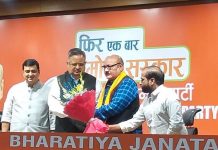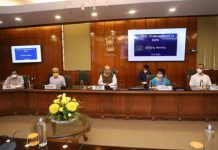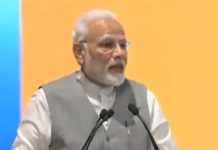
P. Chidambaram, who was a finance minister thrice and presented nine normal Budgets and two interim ones, is an angry man indeed. He worked with several regimes, such as the Congress, the Third Front, UPA-I and UPA-II. He saw the yo-yoing of the country’s economy from its depths in 1991, to its pinnacle between 2005-06 and 2007-08, when it witnessed 8-plus percent growth in 11 consecutive quarters. However, he feels that he has never met a finance minister who knowingly decimated growth.
According to him, it was Pranab Mukherjee, the current President and finance minister during the first four years of UPA-II, who was responsible for the economic mess that India found herself in. He pursued policies that killed ‘inclusive’ growth, which was Chidambaram’s crowning glory during UPA-I. With a single stroke of the pen, in 2009, Mukherjee destroyed the foundations of a sound economy; something that his predecessor had assiduously built and concretised in the past five years.
The current FM, Arun Jaitley, is falling into the same fiscal trap; he is unwittingly pushing himself into a corner just like Mukherjee did. And the disastrous results will show their deadly tentacles within a couple of years, unless he is as lucky as his boss, Narendra Modi. In fact, Chidambaram feels that the worst blunder that any fm can make is to give up on fiscal consolidation and muddle up the financial state of the economy. Both Jaitley and Mukherjee are guilty of it.
Mukherjee and Jaitley differ. The former says that he had no options as the world was caught in the bear hug of the Financial Crisis of 2008. He had to ensure that India didn’t get injured in the process. In Jaitley’s mind, UPA-II’s policies — both Mukherjee and Chidambaram’s — were flawed. His second Budget (February 2015) was the most innovative in the past decade. It would spur growth, lead to development and lift the poor people out of their miseries.
To understand this blame game, as also why the FMs have differed so radically, one has to first go back in time to 2009, when the Congress-led coalition romped back to power. It was the most difficult of times. The developed world, including the US, was in a crisis; experts predicted that the world could witness a ‘Great Depression’, as was the case in the 1930s. Growth dipped globally and there were fears that the same may happen in the fast-growing nations such as China and India.

manufacturing, Photo: AFP
Fiscally Yours
In December 2008, Manmohan Singh, who was both the FM and Prime Minister then, announced the first of the three stimulus packages to accelerate growth. Mukherjee, who became the FM in January 2009 and again in May 2009, when UPA-II assumed power, announced a slew of measures to achieve the same objective. In his 2009 Budget speech, he explained that the aim was to “boost demand and increase expenditure on public projects to create employment and public assets”.
It was a standard Keynesian solution. During the Great Depression of the 1930s, John Maynard Keynes said that the only way out of the predicament was for the various governments to hike public spending. This was what the developed nations did; this was what Mukherjee did. The strategy worked; India and China were the only two nations where growth remained robust.
However, there was a flip side. The three packages impacted the fiscal deficit (the difference between government revenues and expenditure). It more than doubled from 2.7 percent of the GDP in 2007-08 to nearly 7 percent the next year. The total amount of stimulus, at 1,86,000 crore, accounted for the huge jump. It was possibly the single-most factor that led to high inflation, as the government printed money and borrowed more to fund the deficit.
The subsequent huge rise in food prices, over the next few years, sealed UPA-II’s political fate. As items of daily consumption, such as tomatoes, potatoes and onions, zoomed by several hundred percent, the regime’s electoral future was in disarray. Between 2009 and 2013, inflation turned out to be among the major reasons for the Congress and its allies’ defeats in several Assembly elections such as West Bengal, Uttar Pradesh, Tamil Nadu, Karnataka, Bihar and Delhi. In fact, Chidambaram hinted at this in his 2013 Budget speech. “At present, the economic space is constrained because of a high fiscal deficit… (and) a tight monetary policy to contain inflation…,” he said.

Globally Yours
What hurt were the changes in the global arena. Crude oil prices shot up. The price was $80 a barrel on 1 January 2010. By early 2011, it jumped by 50 percent to a high of $120. For the next four years, the price hovered around the $110 mark; it dipped to $90 in mid-2012, but rose back to over $110 within a few weeks. India, which imported the bulk of its fuel requirements, was one of the worst-hit nations. In 2013 and 2014, the country’s oil imports comprised over 70 percent of her annual consumption.
Along with high gold imports (Indians are among the largest buyers of the yellow metal), the yearly import bill rose dangerously. The trade balance, or the difference between imports and exports, doubled to around $200 billion in 2011-12 and 2012-13. The current account deficit (CAD), or the deficit between all forms of earnings and expenses in foreign exchange, went out of control. The combination had a multiplier impact on India’s external economy.
First, between June and December 2014, the rupee went into a tailspin. It steadily fell against the dollar, from 59 to over 63 to a dollar. Experts said that the rupee could breach the 70 or even 80 levels. The fall in the rupee made imports more expensive; India had to pay 63 million to buy $1 million worth of oil, instead of the earlier 59 million. Although a lower rupee helps exports too, or foreign earnings, this didn’t happen because of a weak global economy, thanks to the Financial Crisis of 2008. The trade balance and CAD worsened further
Second, high global crude prices implied that the domestic fuel subsidy shot up. The reason: Indian prices of petrol, diesel and kerosene are sold at lower-than-market rates to woo consumers (potential voters). The difference is partly subsidised by the government and local oil companies are saddled with the remaining losses. The increase in government’s unpaid bills to the latter affected their balance sheets. The energy sector was unable to play a role in energising growth.
The worst was yet to come. A combination of high fiscal deficit, CAD, inflation and trade deficit forced the international rating agencies to focus their economic telescopes on India. Standard & Poor and Moody’s threatened to downgrade India to ‘junk’ status. This would send signals to potential global investors that India was a risky nation to invest in; it could propel the country to the same economic state, as was the case in 1991. UPA-II couldn’t afford it.
Chidambaram, who was reappointed FM in July 2012, tried to bluster his way out. He imposed taxes on the import of gold and electronic items to lower the CAD. But this hiked the difference between the global and domestic prices of these products. Thus, it gave a fillip to smuggling. Investigating agencies like the Department of Revenue Intelligence and Enforcement Directorate said that gold smuggling jumped by 500 percent in 2013 and 2014. The World Gold Council estimated that India’s gold demand remained the same during the period; however, over half of the consumption was smuggled.
The finance minister’s second priority was to checkmate fiscal deficit. Since he couldn’t cut Non-Plan expenses, which normally comprise salaries to government employees and interest payments, he slashed Plan expenditure, which is public spending on manufacturing and infrastructure. It is the latter that enables growth. Chidambaram was willing to sacrifice growth in the short term in a bid to cut fiscal deficit and inculcate fiscal discipline. The strategy worked against UPA-II.
Thankfully Yours
The result: growth slowed down in 2011-12 and dipped the next year. For the first time in the country’s post-Independence history, growth in a year was lower than the previous one for three consecutive years — 8.9 percent in 2010-11, 6.7 in 2011-12, 4.9 in 2012-13 and 4.7 in 2013-14. This proved to be the last economic nail in the electoral coffin of UPA-II.
(Only a dramatic change in the calculation of the GDP by the Modi regime pushed the growth figure to 6.6 percent in 2013-14 and an estimated 7.5 percent in 2014-15. Most experts feel that if growth is calculated as per the earlier formula, it could be around the 5 percent mark in 2014-15.)
Both Mukherjee and Chidambaram were probably happy that Jaitley was left holding the economic baby after the May 2014 elections. The new FM had to take the harsh decisions to deal with the problems. But luck was on Modi and Jaitley’s side. Global crude prices crashed within months. Without taking any major steps, inflation withdrew its ugly head. Lower crude meant a lower import bill and lower CAD. Lower price rise implied higher demand, slightly higher growth and higher government revenues, or lower fiscal deficit. In a jiffy, the economy was back on track.
Although economists and industry have lauded Jaitley on his second Budget, Chidambaram felt that the finance minister’s numbers were highly suspect. A glance at the 2015 Budget figures indicated a slight sleight of the financial hand. Government revenues, including tax revenues, are expected to go up marginally. This hints that the FM is not expecting growth to take off. However, overall receipts are expected to go up by almost 6 percent. Most of the increase in the last figure would be due to borrowings. This is a dangerous sign, as it would lead to higher interest payments later.
On the expenditure side, Plan expenditure on ‘capital account’ is expected to jump by 34 percent. This is a good sign as it can spur public spending. Unfortunately, the total Plan expenses, including that on ‘revenue account’, would come down, and not go up. More importantly, grants for ‘creation of capital assets’, or productive assets, would reduce by over 16 percent. In such a scenario, how does Jaitley hope to spur growth, even as intentions of private investments are down?
Shockingly, Jaitley followed the same strategies as Chidambaram’s in a bid to control the fiscal deficit in 2014-15. He was unable to touch Non-Plan expenditure, which came down minimally; but he slashed the Plan budgets by an astounding 18.6 percent. Given these facts, how does the country hope to achieve a higher growth rate of 6.6 percent this year? May be, only because the formula to calculate growth was changed recently by the BJP regime!
Unfortunately Ours
Despite his clean image, the combination of good, but unsound, policies and the pressures of running a coalition government — UPA-II had 13 political allies — Manmohan Singh was caught red-handed in a series of scams. In a rare instance, the former prime minister was summoned by the Supreme Court to be questioned on his role in the irregular allocation of coal blocks, which were cancelled earlier by the apex court. A series of mammoth scandals — telecom (notional loss of 1,76,000 crore), coal (2,26,000 crore) and Commonwealth Games — rocked UPA-II.
UPA-II’s arrogant and egoistic Cabinet ministers bungled in their defences. They staggered, stumbled and lurched into a state of political drunkenness. The people laughed at their howlers and gaffes, got angry with them and ultimately resolved to throw them out of power. Telecom minister Kapil Sibal claimed that there was zero loss in the telecom spectrum issue, even as the CAG put the notional loss at a staggering figure. Chidambaram said that there was no loss in coal allocations because the mineral was still under the earth and was yet to be mined by private players.
However, as media pressure and criticism from other quarters gathered storm, UPA-II was always on the back foot. There was a sense of policy paralysis as the government was unable to take decisions. Reforms took a back seat; even when Singh tried to push through a few liberalisation moves, like FDI (Foreign Direct investment) in organised front-end retail, there was opposition from within the Congress and its allies. It seemed that there was maximum government, and no governance.
The country waited for a seemingly-strong leader. Modi arrived on the scene, and showcased his achievements during his several tenures as Gujarat chief minister. He convinced the masses that the state clocked high growth rates, which led to the overall development. He showed how his policies boosted manufacturing and agriculture. All this happened because he pursued a strategy of minimum government, maximum governance, complete transparency and lack of any corruption. ‘Na khaunga, na khane doonga’ (I won’t eat, nor will I allow others to do so), was the slogan that he repeated during his election campaign and after he became the prime minister.
In an era of low growth, high inflation and lack of adequate jobs, the corruption scars are the last thing that any government wants on its body-politic. During UPA-II’s rule, it angered all sections of the society, be it the lower, middle or rich classes. It cut across communities, castes and religions. This explains why most sections supported the BJP during the 2014 election.

Paradoxically Everyone’s
Ironically, if one compared the various Budget speeches of Mukherjee, Chidambaram and Jaitley, one can see a number of similarities among them. The crucial issues that they highlighted, the language they used and the emphasis they made seemed as if one had liberally borrowed from the other. This proves that most FMs are part of the same herd and flock. However, people tend to believe someone more than the others, based on the prevailing politico-social-economic atmosphere.
Let’s consider a few examples to establish this conclusion. In his second speech, Jaitley said that one of the three achievements of NDA-II was “the success of Jan-Dhan Yojana”. He added, “Who would have thought that in a short period of 100 days, over 12.5 crore families could have been brought into the financial mainstream?” His reference was to his government’s push to open bank accounts for the poor through this scheme. But was it a novel one?
Jaitley admitted that “financial inclusion” has been “talked about for decades now”. What he failed to mention was that in his speech in 2009, Mukherjee said that UPA-I had started the process to open “no frills (bank) accounts” with “nil or very low minimum balances”. He said that 3.3 crore accounts were opened and the figure would go up because the RBI had further relaxed the norms. In 2010, Mukherjee announced that “appropriate banking facilities” would be opened in all habitations (villages) “with population in excess of 2000 (people) by March 2012”.
In his next year’s speech, Mukherjee said that 73,000 habitations would be targeted for the new banking facilities and the public sector banks had agreed to cover 20,000 of them in 2011-12. He added that the government had initiated a new campaign, Swabhimaan, to use multimedia strategies to “inform, educate and motivate people to open bank accounts”. The difference between NDA-II, and UPA-I and UPA-II: the former arm-twisted the banks to do so.
When it comes to investments and manufacturing, Modi has repeatedly talked about his ‘Make in India’ campaign, which will create jobs, provide a single-window clearance to investors, encourage foreign investment and enhance the skills of the citizens to increase their incomes. In his 2004 speech, Chidambaram hiked FDI ceilings in insurance, telecom and civil aviation. He announced that he would set up an Investment Commission — later Cabinet Committee on Investments — to facilitate clearances to private investors.
Chidambaram said that he would upgrade all the ITIs (Industrial Training Institutes) within five years and create a PPP (Public-Private Partnership) model for the purpose. In 2009, Mukherjee claimed that he would opt for policies that would “create 12 million new work opportunities per year” and reduce the existing poverty level by half within the next five years.

In the past 10 months, Modi’s regime has announced grandiose plans — Digital India to unify the entire country, either through optic fibre network or wireless technologies; Bullet Trains and high-speed trains, and 100 smart cities. UPA-I and II did the same; they talked about a ‘Knowledge Centre’ in every village by 2007, or an attempt to convert Mumbai into a ‘regional financial centre’ to handle global finances between London, Singapore and Tokyo.
Modi has reiterated how he transformed the agriculture sector in Gujarat. He dramatically improved irrigation, recharged the hundreds of water bodies, and provided opportunities to farmers to grow value-added crops like BT cotton, vegetables, fruits and flowers. In 2004, Chidambaram said that India had a million water bodies, such as lakes, tanks and ponds, of which 5,00,000 were used for agricultural purposes. He added that he would initiate a “massive scheme to repair, renovate and restore all the water bodies that are directly linked to agriculture”. In the same speech, he said that his government would double horticulture production by 2011-12.

Ever since Modi came to power and Jaitley became the FM, expectations rose that NDA-II would be able to target subsidies for the poor and, therefore, reduce the leakages. This would improve the country’s finances, said experts. Both Chidambaram and Mukherjee have repeatedly said this. In fact, the UPA’s unique identification scheme, or Aadhaar, was the panacea to achieve this goal. In 2009, Mukherjee said that he wished to re-energise government and improve the delivery mechanisms to the poor. He maintained that Aadhaar would be rolled out in 12 to 18 months.
In the past decade, the faces of FMs changed, they brandished a new philosophy, but their lexicon remained the same. The septuagenarian Mukherjee, mercurial Chidambaram and savvy Jaitley poured the same old economic wine into newer and flashier bottles. However, the people liked some wines better than the others, not because they tasted well, but because the drinkers perceived them so. In the end, as Modi and Jaitley proved, it is the packaging that matters the most.
editor@tehelka.com













